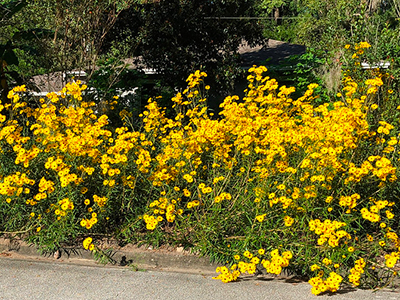Swamp Sunflower

Florida is home to a number of native sunflower species and one of the most attractive is the swamp sunflower. Born to brighten the landscape, attract pollinators, and shelter wildlife, this plant is a must for Florida gardens.
Swamp sunflowers fit nicely into the landscape as a low-maintenance splash of fall color. They are more upright than Florida’s beach sunflowers, but shorter than the iconic giant sunflowers. Mass plantings of these unique natives will keep the neighborhood pollinators buzzing with delight all fall.
Characteristics
Swamp sunflower (Helianthus angustifolius) is an herbaceous perennial native to all regions of Florida. It is cold hardy between USDA Hardiness Zones 8B through 10. In the cooler parts of Florida it may go dormant in the winter, but springs faithfully back to life as soon as temperatures climb.
Setting it apart from other native sunflowers, Helianthus angustifolius’ leaves are rough and narrow; for this reason it is also called “narrow-leaf sunflower.” Clean, bright flowers and dark green foliage are supported by multi-branched stems. They form mounds between 2 and 6 feet high and wide, and lean over to grow in a spreading habit.
Swamp sunflower blooms are a clear, sunny yellow and showy throughout the fall. These flowers are especially attractive to bees and butterflies, making swamp sunflower a perfect choice for a pollinator garden. The thickly-leaved foliage provides wildlife shelter and habitat, too.
Planting and Maintenance

Swamp sunflower performs best in full sun. It will tolerate partial shade but should be pinched in early summer to encourage branching. It successfully grows in well-drained sites, dry to wet sites, and even in soils with some clay.
Plant swamp sunflower at the back of a perennial bed, as a border or edging, or as a mass planting. The clumps fill large spaces well but require some pruning to remain tidy. Sunflowers look stunning installed along a fence line, with the fence providing support and a backdrop for the blooms. Branches near the edge of a clump lean over, draping low walls and hillsides.
We suggest adding it to your landscape between May and July in zone 8, between April and August in Zone 9, and any month except January in zones 10-11. Space plants between 18 and 24 inches apart to leave room for its spreading growth habit. The plants spread rapidly through rhizomes (underground stems). Once these send up new shoots they can be dug up, divided, and moved to add sunflowers to new locations or pass along to friends. Swamp sunflower can also be shared through saved seed, and germinated in a light, soilless mix.
As a Florida native, swamp sunflower tolerates our state’s heat and humidity with ease. These sunflowers are very low maintenance. They respond well to occasional applications of fertilizer and to light irrigation in dry weather but will certainly survive without. Swamp sunflower is susceptible to powdery mildew and spittle bugs but these pests rarely cause extensive damage.
